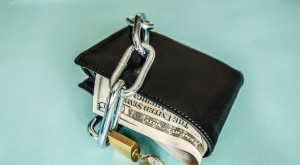Orçamento para pequenas empresas:veja um exemplo real
Trabalhando no orçamento da sua pequena empresa, mas não sabe por onde começar? Às vezes, é útil ver um exemplo da vida real para ajudá-lo a criar seu orçamento. Este post vai te mostrar:
- Um exemplo real de uma pequena empresa de sucesso com todos os números
- Um modelo de orçamento que pode ajudar a gerenciar as dores de cabeça do tempo fiscal
- Custos fixos e despesas variáveis que você deve considerar
Sem mais delongas, veja como Izzy – uma designer e dona de uma pequena empresa – administra as finanças de sua empresa usando um orçamento YNAB para uma configuração financeira calma e sem estresse.
Sobre
- Nome: Izzy K.
- Idade: 33 anos
- Local: Maine
- Trabalho: Suporte ao cliente/designer e pequeno empresário
- Situação de vida: Eu moro com meu parceiro e nosso cachorro.
Sobre a empresa
- O que vendemos: uma linha de joias finas e alianças de casamento personalizadas
- Idade da empresa: 5 anos
- Distribuição: site, atacado para lojas e trabalho personalizado
- Configuração da empresa: LLC de membro único Eu mesmo faço quase todos os aspectos do negócio - da produção ao envio - mas contrato empreiteiros (geralmente amigos talentosos!) projeto por projeto para sessões de fotos e projetos de web design.
Receita e lucro comercial típicos
- Receita pré-covid: US$ 50.000 a US$ 90.000/ano
- receita de 2020: aproximadamente US$ 64.000
- Lucro do negócio: cerca de US$ 30.000/ano em 2020
A pandemia reduziu os pedidos de atacado, pausou feiras e eventos presenciais de artesanato e atrasou muitos casamentos, então meu negócio desacelerou muito no ano passado.
Dinheiro em mãos
- Fundo de reserva: US$ 1.000
- Despesas reais da empresa: Além disso, reservo fundos mensalmente para coisas como assinaturas de software, matérias-primas, custos inesperados e economizo para produtos ou serviços cobrados com pouca frequência ou não mensalmente.
O dinheiro que tenho em mãos varia muito ao longo do ano. A joalheria, como muitos negócios artesanais baseados em produtos, é um negócio muito sazonal. As férias constituem uma grande parte da minha receita anual.
Dívida:$0
- Recebi o empréstimo do Paycheck Protection Program (PPP) e a assistência do Economic Impact Disaster Loan (EIDL), mas ambos foram perdoados, então não tenho nenhuma dívida no momento.
Embora eu esteja muito agradecido por ambos terem sido perdoados, a inscrição foi muito estressante – as orientações continuavam mudando!
Com o dinheiro da assistência, investi na reformulação do site de uma pequena empresa de design. Mesmo antes da pandemia, eu estava tentando fazer menos mercados presenciais, então essa era uma maneira de investir na construção de mais vendas online e apoiar outra pequena empresa criativa cujo trabalho eu admirava.
Entrada média mensal:US$ 3 mil a US$ 20 mil
Como as joias finas são tão sazonais, minhas entradas variam bastante. Nos meus meses mais movimentados (novembro/dezembro), eu poderia arrecadar $ 20.000 – enquanto em um dos meus meses mais lentos (como março), poderia ser apenas $ 3.000.
Meu orçamento para pequenas empresas
Orçamento
| Categoria | Valor alvo | Observações |
| Empate + Pagamento do Contratado | ||
Desenhar do proprietário  | $2.000 | Eu me pago um sorteio mensal de proprietários. |
Pagamento do Contratado / Linha 11  | $300 | Coloco dinheiro aqui projeto por projeto. |
| Pagamentos com cartão de crédito | ||
Cartão Um Capital  | $0 | Abri dois cartões de crédito com a atração do bônus de inscrição comercial. Provavelmente eliminarei o cartão Chase. |
Cartão de Perseguição  | $0 | |
| Despesas Mensais | ||
Shopify – linha 8  | $29 | Plataforma de comércio eletrônico do site. |
Klaviyo – Linha 8 – marketing  | $30 | Plataforma de newsletter por e-mail |
Shipstation – Linha 27 – software  | $10 | Este serviço me permite imprimir e enviar pacotes USPS e UPS de casa. |
Domínios e e-mails – Linha 8  | $10 | Faturado anualmente, economizo esse valor todo mês. |
Planoly – Linha 27  | $6 | Agenda e publica automaticamente no Instagram. |
Adobe – Linha 27  | $30 | Eu uso mais Indesign, Photoshop e Bridge. |
MileIQ – Linha 27  | $6 | Este é um aplicativo de telefone que rastreia a milhagem de negócios. Deslize em uma direção para viagens pessoais, deslize na outra direção para viagens de negócios. |
| COGS – Parte II | ||
Materiais – linha COGS 38  | $1.084 | Faço orçamento para materiais e suprimentos conforme necessário. Os preços dos metais variam bastante e acabo movimentando dinheiro com frequência. |
Suprimentos – CPV Linha 38  | $38 | |
Embalagem – CPV Linha 38  | $94 | |
Envio – Linha 27  | $0 | |
| Despesas trimestrais | ||
Impostos trimestrais  | $330 | Calculo os impostos necessários com base nas vendas ou no ano anterior. |
Imposto sobre vendas e uso – linha 23  | $79 | Recolho impostos sobre vendas para pessoas no Maine (sou pequeno o suficiente para não precisar coletar em todo o país) ou quando viajo para eventos presenciais em diferentes estados. Sempre que recebo um pedido/compra em que o imposto sobre vendas precisa ser cobrado, coloco esse dinheiro de lado nesta categoria. |
| Despesas variáveis | ||
Fundos flexíveis  | $71 | Este é meu fundo de reserva. Eu coloco dinheiro restante de outras categorias aqui. |
Marketing – Linha 8  | $0 | Anúncios pagos |
Materiais de Impressão – Linha 8  | $50 | |
Ferramentas e Equipamentos – linha 22  | $60 | |
Suprimentos – Linha 22  | $0 | |
Despesas de escritório – Linha 18  | $0 | |
Devoluções do Cliente – Linha 2  | $0 | |
| Programas/Viagens | ||
Taxas do fornecedor – linha 10  | $0 | |
Exibir – Linha 8  | $0 | |
Viagem – Linha 24A  | $500 | Tenha um próximo show no outono. |
Refeições Dedutíveis – Linha 24 B  | $0 | |
| Despesas variáveis pouco frequentes | ||
Educação Continuada – Linha 27  | $0 | |
Comissões e taxas – Linha 10  | $0 | |
| Despesas Anuais | ||
Impostos e Licenças – Linha 23  | $7 | Registro de LLC. Formulários que acontecem uma vez por ano |
| Salvando | ||
Lucro – 5% – março junho setembro dezembro  | $16 | 5% das vendas vão aqui. Tenha $ 543. Pago a mim mesmo uma distribuição trimestralmente. |
Fundo de reserva  | $0 | Com limite de US$ 1.000 |
Reembolso de empréstimo PPP  | $0 | Pronto não precisava disso. |
| Total necessário $ 4.750 | ||
About My Budget
My small business budget is set up in YNAB and it’s worked really well to measure my financial health and help with short and long-term planning.
I keep my owner’s draw category at the top of my budget to keep the number in front of me. I found early on in my business I was so excited about the idea of “business expenses” that it was easy to fritter money away. It’s all a tradeoff—every time I buy something, it could mean you can’t pay yourself as much, and I’m reminded of that tradeoff every time I open my budget.
I file taxes as a sole proprietor (Schedule C for taxes). To make it easier for tax purposes, I set up my budget to include the corresponding line number of the Schedule C form. Accounting software like Quickbooks and Xero do these things behind the scenes, but I do it actively in YNAB.
There’s an accounting firm called Sunlight Tax that specializes in accounting for creative small businesses that also provides a lot of education—I took a workshop with them and learned so much about better organizing my bookkeeping and how to create a business budget. The owner, Hannah Cole, was actually on the YNAB podcast talking about how artists and creatives can simplify their taxes.
How I Manage Money with My Small Business
To manage money in my business, I use:
- A business checking account
- A checking account with Square
- A high-yield savings account with Square
- Two credit cards that I pay off in full each month
- YNAB to budget and keep everything organized
I used Quickbooks Online in previous years as my small business budget—mostly because I thought it was what “real” businesses used and because it was what the accountant I was working with at the time recommended. But I found YNAB was even more helpful in decision making and planning. In YNAB I can see my runway based on the money I had in my accounts—literally the period of time I have until the money in my accounts will run out and what it will cover.
Seeing my income and expenses in this light empowered me to invest in the website redesign project because I could see exactly what would happen in my budget if I moved money to a “website” category. I like that YNAB lets you take care of what you need to for tax compliance but also serves as a decision-making tool when you’re budgeting for your business.
Learn how to set up a business budget in YNAB.
A few times a week, I’ll pop into my budget to import and categorize transactions. Friday is my big day to do money things:
- I reconcile my budget to my bank account to make sure they match
- I move money around to cover any overspending (a key principle in zero-based budgeting)
- Any other more irregular things (like paying sales tax or paying out invoices) I also do on Friday.
I set up Square, Shopify, and Stripe to deposit once a week on Thursdays, so the money is there on Friday to allocate.
With my business budget, I’m always a month ahead with expenses:when money comes in, I budget out a month before I fill up my owner’s draw category and start filling in other more “optional” categories. For example, when I flip into October, I’ll go into November’s set expenses and fill those up.
For taxes, I’ve worked with an accountant before but this past year I did my own taxes because I’m very interested in them (thanks to Sunlight Tax!). I think generally it does make sense to work with an accountant and I really liked the one I worked with previously.
Every quarter (September, January, April, June), I sit down and figure out my profit. Based on that number, I submit my estimated taxes. When it comes to April’s annual taxes, the self-employment tax I owe has already been submitted and I’m usually pretty close to the right amount.
How I Got into Running My Own Small Business
I was an English major and I’ve always been creative. I never set out to start my own jewelry line, but after working for a number of other design studios I decided to take the leap.
As a creative, I think I’d always been told I wouldn’t like the numbers side of running a business. I’d absorbed the narrative that creative people don’t like money. That’s not true and not helpful.
I went through a community-based entrepreneurship training during the first year of running my business that went over basic business financial topics like running a breakeven or cash flow analysis. It turned out I actually love the numbers side of the business—it’s so interesting.
The business is now five years old, and the creativity never stops when I leave my studio. To me running a business feels like a holistic creative practice—figuring out logistics like shipping and packaging, determining how to learn the new skills I need, structuring my budget and constantly re-evaluating how to best use the resources I have available—it’s all deeply creative.
Minhas metas financeiras
When it comes to business performance, I want to shift to more online-centered sales so I don’t have to travel as much as I had before the pandemic. I’d like to break $100,000 in revenue and make the business more profitable as time goes on too. Early on, I was spending money on accumulating equipment and tools, so much of the money I was making was going straight back into growing the business.
Personally, we’re saving for a down payment and I’d love to build a tiny house or freestanding studio in the backyard for my business.
In the big picture, running my own business gets myself and my partner closer to our goal of financial independence, and having control over our time.
I would rate my current business financial situation as a 3.5/5. I’m working towards building more revenue and streamlining the business to make it more profitable but I also feel truly proud of how far the business has come.
But I would rate my current peace around finances:5/5. I feel clarity around what I want to do with my business resources and after having been in business for a few years not too many variable costs truly surprise me anymore.
You’ve been perusing small business budgeting templates, are you ready to turn one into the real thing? Learn more about using YNAB to manage your small business budget.
Want to keep going? The budget nerds talk to Laura on how she uses YNAB and the Profit First method to manage their small business. The Profit First method transforms businesses from cash-eating monsters to money making machines, and YNAB helps you execute your plan.
despesas
- Como obter um empréstimo para pequenas empresas
- Empréstimos para pequenas empresas para mulheres
- 2 exemplos de um plano de seguro para pequenas empresas
- Usos de pequenas empresas para orçamento de item de linha
- Qual método de orçamento para pequenas empresas você deve escolher?
- Planejamento de orçamento de publicidade para sua pequena empresa
- Controle de Orçamento com Racionamento de Capital
- Elaboração de um orçamento financeiro para sua empresa
-
 9 melhores sites para pequenas empresas em 2022
9 melhores sites para pequenas empresas em 2022 Vários fatores, dependendo do setor e do objetivo, são necessários para tornar um site de pequena empresa ótimo. Estes são alguns dos nossos sites favoritos para pequenas empresas. Um bom design de s...
-
 Um guia de pequenas empresas para orçamentos flexíveis
Um guia de pequenas empresas para orçamentos flexíveis Um orçamento flexível pode ser um recurso útil para os empresários que lutam para orçar adequadamente os custos variáveis. Se você fabrica produtos, veja como um orçamento flexível pode ajudar seu neg...


